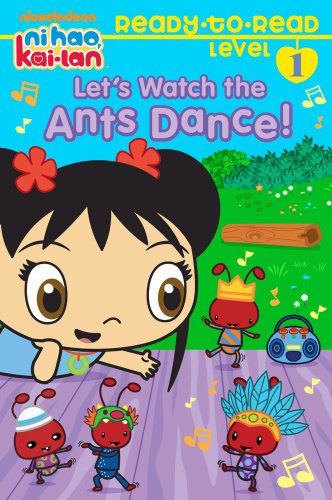Have you ever wondered what the world looks like from the perspective of an ant? In the vibrant and educational world of “Ni Hao, Kai-Lan,” we get a glimpse into this fascinating microcosm, particularly through the iconic “Ants Dance.” It’s not just a catchy tune for toddlers; it’s a playful introduction to the complex social structure and tireless work ethic of these tiny creatures. This article takes a deeper dive into the “Ants Dance,” exploring its cultural influence, scientific accuracy, and ultimately, what it teaches us about the importance of teamwork and perseverance.

Image: oveg.ru
The “Ants Dance” is more than a simple children’s song; it’s a cultural touchstone. It reflects the deep-rooted cultural fascination with ants, particularly in China, where “Ni Hao, Kai-Lan” originated. Ants have long been admired for their dedication to their colony, their tireless efforts, and their remarkable sense of purpose. This admiration is woven into the fabric of Chinese folk tales and proverbs, solidifying the image of the ant as a symbol of hard work and perseverance.
Stepping into the Ant World
Delving into the Dance:
The “Ants Dance” is an infectious tune, mimicking the synchronized movements of ants as they carry food and build their nests. The playful repetition of the lyrics, “Carry, carry, carry,” captures the essence of ant work, emphasizing the importance of each individual’s role within the colony. The dance’s vibrant choreography, with arms outstretched and bodies moving in unison, further illustrates the cooperative nature of ant society.
Beyond the Nursery Rhymes:
It’s important to recognize that the “Ants Dance” isn’t just about entertainment. It serves as a window into the scientific world of ant behavior. While simplified for young viewers, the dance touches upon real aspects of ant life, such as foraging, communication, and the complex social hierarchy that governs their colony. For instance, the iconic “carry, carry, carry” resonates with the ants’ constant need to gather food and materials for their nests.

Image: www.fanpop.com
The Science of the Dance:
A Peek into Ant Society:
Ants are remarkable creatures. They live in highly organized colonies, each member playing a specific role. The queen, the heart of the colony, is responsible for laying eggs, while worker ants perform tasks such as foraging, nest building, and caring for the young. The “Ants Dance” subtly reflects these intricacies, portraying the ants as a cohesive unit working together for the greater good.
Unraveling Ant Communication:
The song also indirectly touches upon the fascinating world of ant communication. Ants don’t communicate through sound like humans; they rely on chemical signals called pheromones. These pheromones leave trails that other ants can follow, leading them to food sources or back to the nest. The synchronized movements in the dance could be interpreted as a visual representation of how ants use these chemical trails to navigate and collaborate.
Learning from the Ants:
The Importance of Teamwork:
The “Ants Dance” teaches a valuable lesson about the power of teamwork. Just like ants, who work tirelessly for the benefit of their colony, humans can achieve amazing things when they collaborate. Whether it’s a group project in school or a complex undertaking at work, understanding the importance of teamwork can set us up for success.
Perseverance and Hard Work:
Ants are renowned for their perseverance and unwavering work ethic. Despite their small size, they can move incredibly heavy objects and build complex structures. This spirit of determination is reflected in the repeated “carry, carry, carry” of the “Ants Dance.” It teaches children to embrace challenges, work through difficulties, and keep trying until they achieve their goals.
Ni Hao Kai Lan The Ants Dance
Conclusion:
The “Ants Dance” from “Ni Hao, Kai-Lan” isn’t just an enjoyable song; it’s a microcosm of ant behavior and a valuable lesson about teamwork and perseverance. It blends cultural understanding with scientific accuracy, showcasing the beauty and complexity of these fascinating insects. As children sing along and mimic the ants’ movements, they’re unknowingly learning valuable life skills and gaining a deeper appreciation for the intricacies of the natural world. It’s a testament to the power of storytelling and how even seemingly simple children’s entertainment can hold profound lessons and open doors to new discoveries.






